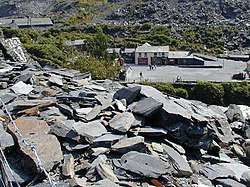Llechwedd quarry
Llechwedd quarry (Welsh pronunciation: [ɬɛχˈwɛð]) is a major slate quarry in the town of Blaenau Ffestiniog, north Wales. At its peak in 1884 it produced 23,788 tons of finished slate per year and had 513 employees. It continues to produce slate on a limited scale and is the location of the Llechwedd Slate Caverns tourist attraction.
 Tips at the quarry in 2000 | |
| Location | |
|---|---|
 Llechwedd quarry Location in Gwynedd | |
| Location | Blaenau Ffestiniog |
| County | Gwynedd |
| Country | Wales, UK |
| Coordinates | 53.0021°N 3.9347°W |
| Production | |
| Products | Slate |
| Type | Quarry |
| History | |
| Opened | 1846 |

History
As early as 1831, permission was sought to begin quarrying near Llechwedd Farm, however this came to nothing.[1]
The Llechwedd slate quarry was opened in 1846 by John Whitehead Greaves, a successful quarry owner. Greaves had a history with the slate quarries at Blaenau Ffestiniog, and had proposed a railway to link the quarries with the river wharf at Dwyryd as early as 1836. When the Ffestiniog Railway was opened in 1836, connecting Blaenau Ffestiniog with the sea at Porthmadog, Greaves travelled on the historic first train.[2]
In 1843 Greaves was elected the treasurer of the Ffestiniog Railway and in 1844 he became its chairman.[2] This began a long association between the railway and the Greaves family.
By this time Greaves was running the Diffwys and Bowydd quarries under leases from their landowners. In 1846 Greaves and his partner Edwin Shelton leased pasture land nearby at Llechwedd and began prospecting for slate. They gave up their rent of Bowydd at this time. By 1847 miners located the "Old Vein" at Llechwedd and development of the quarry began under the management of John's son John Ernest Greaves. An incline was built to connect the quarry with the Ffestiniog Railway (FfR) which was extended from its terminus at Dinas to meet the incline. This work was completed on 30 June 1848.
In 1851 2,900 tons of finished slate was produced by Llechwedd and shipped over the FfR and the company moved its offices to Porthmadog, the terminus of the railway. There a slate wharf dedicated to Llechwedd was built in 1853 where the quarry's products were trans-shipped to a fleet of sailing boats for transport to their markets. The quarry continued to increase production in the 1850s and 1860s, with 7,620 tons shipping in 1863.
In 1890 Llechwedd began to introduce electrical power,[1] becoming the first quarry in the Ffestiniog area to do so. Because of the high rainfall in Blaenau Ffestiniog the quarry used its own hydro-electric generating station to provide this power.
In 1909 Richard Greaves, the son of John Ernest, became chairman of the Ffestiniog Railway.
In 1932 a Blondin aerial ropeway was installed at Llechwedd and three years later a major new mill was built. Work at the quarry continued during World War II with production increasing temporarily after the conflict. In 1957, Llechwedd started shipping out finished slates by lorry to the wharves at the LMS station at Blaenau Ffestiniog, though this practice only lasted until 1962.[1]
The 1960s saw a steep fall in the demand for slate. Llechwedd turned their attention to other potential sources of revenue, and in 1972 opened the Llechwedd Slate Caverns tourist attraction. The same year the quarry owners purchased Diphwys Casson Quarry to the south. In 1975, further consolidation occurred when Llechwedd also purchased Votty & Bowydd Quarry, Maenofferen Quarry and Rhiwbach Quarry.[1]
Quarry operations continue at Llechwedd in 2013, though on a limited scale and using open cast mining techniques. The owners are also untopping Votty & Bowydd and Maneofferen quarries.
Transport
Locomotives
| Name | Type | Builder | Date | Works number | Notes |
|---|---|---|---|---|---|
| Freda | 0-4-0 VB | De Winton | 1874[2] | Sold to Tonfananu quarry 1898; scrapped about 1906 | |
| 0-4-0 VB | De Winton | 1879[2] | Sold or scrapped around 1898 | ||
| Edith | 0-4-0 IST | W.G. Bagnall | 1890 | 1278 | Converted to The Coalition, 1931[1] |
| Margaret | 0-4-0 IST | W.G. Bagnall | 1895 | 1445 | Stored out of use by 1963 |
| Dorothy | 0-4-0 ST | W.G. Bagnall | 1899 | 1568 | Converted to The Eclipse, 1927[1] |
| No. 1 | 4w BE | Wingrove & Rogers | 1922 | 302 | |
| No. 2 | 4w BE | Wingrove & Rogers | 1922 | ||
| Welsh Pony | 4w BE | Wingrove & Rogers | 1925[1] | Out of use 1964 | |
| The Eclipse | 0-4-0 OE | Llechwedd | 1927 | Electric locomotive built on the chassis of Dorothy at the quarry. Supplied from overhead electrical wires | |
| The Coalition | 0-4-0 OE | Llechwedd | 1931 | Electric locomotive built on the chassis of Edith at the quarry. Supplied from overhead electrical wires | |
| No. 3 | 4w BE | Wingrove & Rogers | 1935 | ||
| 4w PM | Llechwedd | 1936 | Built at the quarry from a Morris road lorry; out of use by 1964 | ||
| 4w BE | Wingrove & Rogers | 1936 | 918 | Ex Maenofferen Quarry 1947 Later returned to, and now out of use at, Maenofferen |
Geology
Description
References
- Isherwood, Graham (July 2009). "Chronology of Llechwedd Quarry". Cite journal requires
|journal=(help) - Wynne Jones, Ivor; Hatherhill, Gordon (1977). Llechwedd and other Ffestiniog Railways. Quarry Tours Ltd. ISBN 0-9502895-9-0.
- Boyd, James I.C. (1975). The Festiniog Railway: Volume 2. The Oakwood Press.
External links
| Wikimedia Commons has media related to Llechwedd quarry. |
- AditNow - Photographic database of Llechwedd Slate Mine